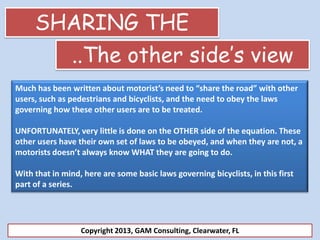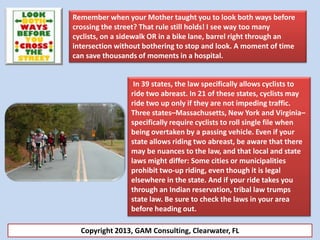Sharebike
- 1. SHARING THE ROADâĶ..The other sideâs view Much has been written about motoristâs need to âshare the roadâ with other users, such as pedestrians and bicyclists, and the need to obey the laws governing how these other users are to be treated. UNFORTUNATELY, very little is done on the OTHER side of the equation. These other users have their own set of laws to be obeyed, and when they are not, a motorists doesnât always know WHAT they are going to do. With that in mind, here are some basic laws governing bicyclists, in this first part of a series. Copyright 2013, GAM Consulting, Clearwater, FL
- 2. In most states, a cyclist is REQUIRED to ride WITH the traffic, not against it, if on a roadway or bike lane. This is probably one of the most often violated rule, and one that can cause grief for drivers. When making a right turn, the LAST thing a driver expects to see is a wrong-way rider coming at him/her. This sudden meeting can cause a collision with the cyclist (head-on!), or cause the driver to swerve suddenly, with a potential for hitting a car in the next lane, or losing control. It is important to remember that BOTH road users are subject to the same rules. Just as a car cannot drive on the sidewalk, neither can a cyclist (SOME local jurisdictions DO allow for this). If a cyclist wants to make a left turn, (s)he has the right to do so, IF they get to the left-turn lane or left side of a driving lane. On right turns, a cyclists may not overtake, on the right, a car that is turning right (ONE MORE good reason for car drivers to use their turn signals! Copyright 2013, GAM Consulting, Clearwater, FL
- 3. Remember when your Mother taught you to look both ways before crossing the street? That rule still holds! I see way too many cyclists, on a sidewalk OR in a bike lane, barrel right through an intersection without bothering to stop and look. A moment of time can save thousands of moments in a hospital. In 39 states, the law specifically allows cyclists to ride two abreast. In 21 of these states, cyclists may ride two up only if they are not impeding traffic. Three statesâMassachusetts, New York and Virginiaâ specifically require cyclists to roll single file when being overtaken by a passing vehicle. Even if your state allows riding two abreast, be aware that there may be nuances to the law, and that local and state laws might differ: Some cities or municipalities prohibit two-up riding, even though it is legal elsewhere in the state. And if your ride takes you through an Indian reservation, tribal law trumps state law. Be sure to check the laws in your area before heading out. Copyright 2013, GAM Consulting, Clearwater, FL
- 4. This New Mexico law sign sums it up quite well. A CROSSWALK (which, by definition, is an extension of the SIDEWALK) is for pedestrians. Most states have similar laws, in that a cyclist on a sidewalk or crosswalk, must either WALK their bike across, or ride at a speed equal to or less than the foot traffic of pedestrians. The laws for both motorists and cyclists only work when they are adhered to, and respected, by BOTH groups. SHARE the road means exactly thatâĶno ONE group has more ârightsâ than the other, on todayâs increasingly crowded roadways. Copyright 2013, GAM Consulting, Clearwater, FL



